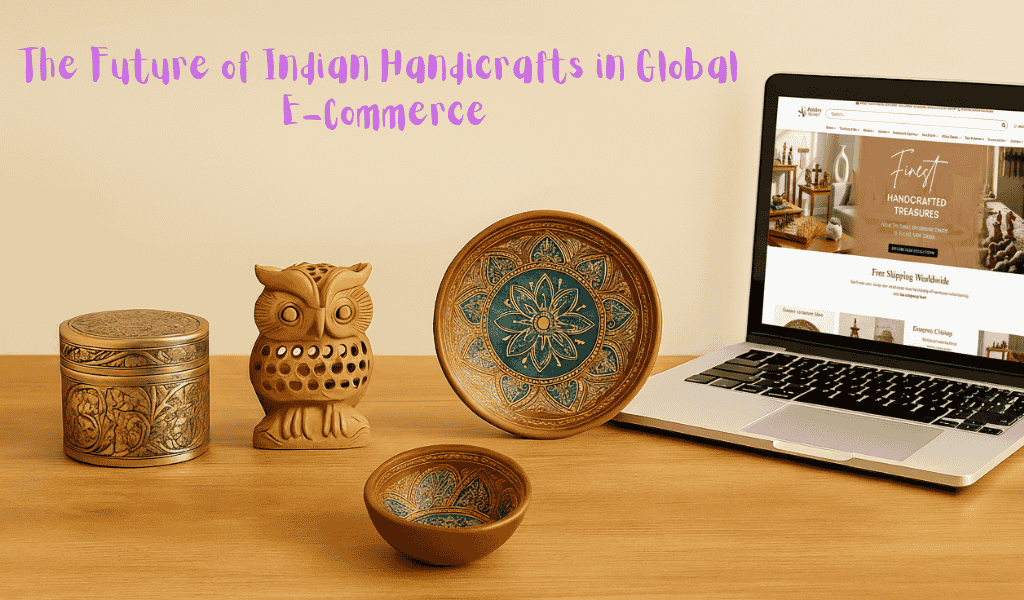Indian handicrafts are an emblematic representation of the rich culture of the country. These handmade products represent a legacy of India’s myths, traditions, land, and society. This is a work of art that is transferred by the elders to the next generations. However, in today’s e-commerce market, there’s a growing appetite for these items. Also, the future looks very bright due to many factors. Keep on reading to gain insight into the impact of Indian handicraft products on the global e-commerce sector in the coming years.
Key Trends to Watch
People are infatuated with the products that have a story. They are not only interested in something to use—they want something that connects them to culture, tradition, and creativity. Indian handicrafts are perfect for this trend. Whether it’s a wall hanging or a wooden animal figurine, each item has a meaning that you will not see in any machine-made item in general. Sustainability is another factor that buyers look for the most. They prefer products that are non-toxic and responsibly made. Indian artisans often use natural dyes and materials and passed-on techniques.
Millennials and Gen Z are the buyers. They love buying unique things online, sharing them with friends, and supporting artisans over big brands. Surveys show that over 60% of young buyers prefer brands that respect culture and skill. Social media and online marketplaces have made it a breeze for these generations to purchase Indian handicrafts from anywhere in the world.
Digital Transformation of Handicraft Businesses
Indian handicrafts are starting a new era because of technology. Earlier, they were limited to local markets, but now they can be bought across continents with a click. Platforms like ArtistryBazaar are helping artisans market their work to global buyers.
Moreover, new tools like augmented reality (AR) and virtual reality (VR) are changing how people experience handicrafts. For example, a customer can now “place” any handmade home decor items in their living room through AR, or take a VR tour of a craft village in India while sitting halfway across the world. These experiences build trust and create real emotional connections with the products.
Also, technology is helping artisans/vendors make educated choices. AI and data analytics software can help them know what people like, what’s trending, and which creations sell best. This helps creators to plan collections as per the demands of the buyers’ preferences and on schedule. The digital transformation of Indian handicrafts is an opportunity for artisans to expand their target market, preserve their craft, and share India’s rich cultural heritage with the world.
Innovative Business Models for the Future
The way Indian handicrafts are traded is also changing fast. The first business model is direct-to-consumer (D2C) selling. Artisans can now connect directly with buyers and advertise their products, stories, inspirations, and even their creative process. When customers see the hands and, passion and hard work behind a product, buying becomes personal.
The second model is the subscription and customized handicraft boxes. Just imagine receiving a box every month full of handmade items. The third business model is collaboration. Artisans will be working with designers, brands, or even tech companies to create products that are a combo of tradition with modern trends. These new models show that the future of Indian handicrafts is bright. By connecting directly with buyers, curating experiences, and doing collaborations, artisans can reach people worldwide to keep their art alive and profitable.
Market Opportunities for Indian Handicrafts
The whole world will notice Indian handicrafts in a few years. Europe, North America, and Asia are already looking for handmade products for different needs. Whether it’s home decor or office decor, Indian crafts are becoming a way for people to add culture to their spaces.
There’s a growing demand in niche markets, too, and it will increase with time. Plus, they are attracting buyers who care about the planet. Products like handmade jute bags, flower vases, or wooden picture frames are choices that reflect values. At the same time, luxury and bespoke crafts are finding their own space. Personalized ceramics or custom artisan home furniture are being sought after by buyers who want something unique and exclusive. E-commerce is a key factor responsible for these market opportunities. Small artisans from Indian villages can now reach buyers without middlemen.
It is not wrong to say that the future is wide open. Indian handicrafts can grow beyond borders if artisans combine their centuries-old skills with online marketing and innovation. Every handmade product has the potential to connect with a buyer halfway across the world and create a global experience that is meaningful, personal, and unforgettable.
Upcoming Challenges and Their Solutions
No doubt, Indian handicrafts are making and will make an impact on global e-commerce, but there are some challenges. The major challenge is to keep the handmade factor alive in products while appealing to more customers. As we all know, handcrafted items take time and care to get ready, which may not fit the rush of the online market. So, focus on limited editions and the stories behind each product. Share videos of artisans at work or the history of a craft to make customers feel connected and ready to wait for it.
Another challenge is shipping products from small villages to global buyers in a timely manner. Many artisans face shipping delays or damage during transit. In this situation, you can use local hubs for packing and shipping to pack these fragile items, and better logistics with courier services will help craftsmen deliver on time without losing quality.
Digital adoption is another challenge. Not everyone knows how to sell online or manage payments. Here, you can get help from government programs, NGOs, and online marketplaces. They offer training, support, and easy-to-use apps that connect artisans with buyers worldwide. With the right balance of technology and support, Indian handicrafts can overcome these challenges.
Last Word
The future of Indian handicrafts in global e-commerce depends on the convergence of tradition and technology. Artisans will have the chance to showcase their craft to the world as never before. Platforms like ArtistryBazaar are filling this gap by connecting craftsmen directly with global buyers. Also, with the right digital tools and ethical practices, Indian handicrafts can lead the global stage and preserve culture while driving growth. We offer free worldwide shipping, door-to-door delivery, flexible payments (just 30% upfront and 70% before dispatch), and an extra up to 10% off with our promo code.

